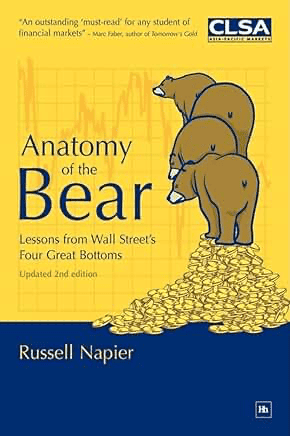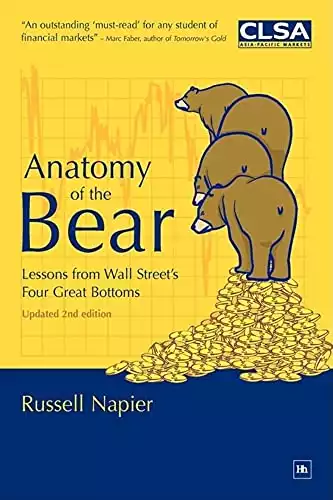Overview : Anatomy of the Bear
- Book Title: Anatomy of the Bear
- Author: Russell Napier
- Publication Date: January 2005
- price: $16.41
- Pages: 262
Overview of the Book
The Anatomy of the Bear: Lessons from Wall Street’s Four Great Bottoms is written by Russell Napier, a financial historian and investment strategist known for his deep insights into market cycles and valuation.
Introduction
In the ever-fluctuating world of finance, understanding market cycles is crucial for investors seeking long-term success. Russell Napier's "Anatomy of the Bear: Lessons from Wall Street's Four Great Bottoms" offers a compelling exploration of historical market downturns, providing invaluable insights for modern investors. This comprehensive review delves into Napier's analysis of four significant bear markets, examining how his findings can inform today's investment strategies.
Book Summary
"Anatomy of the Bear" meticulously examines four pivotal bear markets in U.S. history: 1921, 1932, 1949, and 1982. Napier's work stands out for its depth of analysis, combining economic data, social context, and market psychology to paint a vivid picture of each downturn. By identifying patterns and signals preceding these market bottoms, Napier equips readers with tools to potentially recognize future market lows.
"The bear market bottom is characterized by extreme pessimism, yet it's precisely this sentiment that lays the foundation for the next bull market." - Russell Napier
Analysis of Themes
Market Sentiment and Investor Psychology
A central theme in Napier's work is the role of market sentiment in driving stock prices. He argues that extreme pessimism often precedes market recoveries, creating opportunities for astute investors. This insight into investor psychology provides a valuable framework for understanding market dynamics beyond mere numbers.
Macroeconomic Indicators
Napier emphasizes the importance of macroeconomic factors in shaping market cycles. His analysis of interest rates, inflation, and corporate earnings offers readers a comprehensive view of the economic forces at play during bear markets. This approach aligns well with modern investing strategies that consider broader economic trends.
Long-Term Perspective
The book advocates for patience and a long-term investment approach, a message that resonates in today's fast-paced financial world. Napier's emphasis on resisting short-term market fluctuations provides a valuable counterpoint to the often frenetic nature of modern investing.
Writing Style and Accessibility
Napier's writing strikes a balance between technical analysis and engaging narrative. While the content can be dense at times, his use of historical context and clear explanations makes complex financial concepts accessible to a broader audience. The inclusion of charts, graphs, and historical data enhances the reader's understanding and supports Napier's arguments effectively.
Strengths and Weaknesses
Strengths:
- In-depth historical analysis of significant market bottoms
- Clear explanations of complex financial concepts
- Valuable insights into market psychology and investor behavior
- Practical lessons applicable to modern investing strategies
Weaknesses:
- May be challenging for readers without a finance background
- Focus on historical data might not fully account for modern market complexities
- Limited discussion of recent technological impacts on markets
Comparison to Other Works
"Anatomy of the Bear" stands out in the crowded field of investment literature for its focused analysis of market bottoms. While books like Benjamin Graham's "The Intelligent Investor" offer broader investment principles, Napier's work provides a unique perspective on specific market events. Compared to more recent works like "The Big Short" by Michael Lewis, which focuses on a single market crisis, Napier's book offers a longer historical view, making it valuable for understanding market cycles over time.
Relevance to Modern Investing
Despite its focus on historical events, "Anatomy of the Bear" remains highly relevant to contemporary investors. The lessons drawn from past market bottoms can inform strategies for navigating today's volatile markets, including:
- Recognizing potential buying opportunities during market downturns
- Understanding the interplay between economic indicators and market performance
- Developing a disciplined, long-term approach to investing
- Assessing market sentiment and its impact on stock prices
These insights are particularly valuable in the context of recent market trends, including the rise of cryptocurrencies and the impact of global events on financial markets.
Highlights from Anatomy of the Bear
- Bear markets: Analyzes historical bear markets and their causes.
- Investor psychology: Explores the emotional factors influencing market downturns.
- Long-term perspective: Emphasizes the importance of patience during market declines.
- Market cycles: Identifies patterns and phases of market recovery.
- Investment strategies: Recommends disciplined strategies to navigate bear markets.
- Historical lessons: Draws insights from past bear markets to guide future investors.
- Resilience in investing: Encourages staying committed to long-term goals despite market volatility.
Conclusion
"Anatomy of the Bear: Lessons from Wall Street's Four Great Bottoms" is an essential read for investors, financial analysts, and anyone interested in understanding the intricacies of market cycles. Russell Napier's thorough analysis of historical downturns provides timeless lessons that can be applied to modern investing strategies. While the book's focus on historical data may not fully capture the complexities of today's technology-driven markets, its emphasis on fundamental economic principles and investor psychology remains highly relevant. For readers willing to engage with its detailed analysis, "Anatomy of the Bear" offers invaluable insights into recognizing and capitalizing on market bottoms. In an era of increasing market volatility and economic uncertainty, Napier's work serves as a guide for investors seeking to navigate bear markets successfully. By understanding the patterns and signals that preceded past market recoveries, readers can better position themselves to weather future downturns and seize opportunities for long-term growth.
For those looking to deepen their understanding of market cycles and improve their investment strategies, "Anatomy of the Bear" is a must-read. You can purchase the book through our affiliate link below and start your journey towards more informed investing today. [Affiliate Link: Buy "Anatomy of the Bear" on Amazon] By incorporating the lessons from Napier's analysis into your investment approach, you'll be better equipped to navigate the complexities of modern financial markets and potentially identify opportunities where others see only risk.





